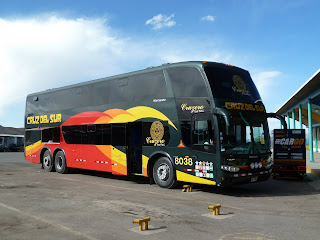Puno is a nice enough town on the north-west shore of Lake Titicaca. Tiny little streets and a maze of them with pavements so narrow that two people pass only with difficulty. The locals, in the town, are 'Aymara' whereas on the lake they are 'Uros'. You can tell, as with all the Peruvian clans, by the hats worn by the women. It lies at over 13,000 ft so it gets really cold out of the sun and the air is a bit on the thin side, although I think I am getting used to that. The town has a plethora of 'fax' and internet shops. It seems in Peru that if one type of shop is successful ( vis-a-vis shoe shops in Lima or money exchange shops in Cusco ) then everyone gets in on the act to the benefit of noone
Left: The Plaza de Armas in the centre. I stayed in a delightful little hotel, the Hotel Plaza Major, just behind where I was standing here. The lady proprietress, Milly, spoke excellent English ( a rarity ) and was most helpful. Lots of good restaurants as well.
Right: These ladies are Aymara. They all wear twee little bowler hats, either brown or black, with the normal colourful ponchos over their shoulders to carry their kit in. It has been noticeable that all Andean women seem to be a bit on the stocky side; built more for comfort than speed it could be said.. Or it may just be that they wear a lot of clothes to keep warm.
Left: Local taxis, small adapted tricycle-motorbike things with a cosy enclosed passenger compartment which has a bench seat. Some even have seat belts!
Right: A clutch ( what is the collective noun? ) of Puno's finest. Why is it that most of the Latin American traffic police look as if they are about to ride at Hickstead?
Left: The little boat that took us out onto Lake Titicaca to visit the floating islands. Our guide here, Giovanni, was, as with all the guides, very good. At least he could speak using facts and not, as with the Inca ruins tours, rely on guesswork and theory. Lake Titicaca is the highest 'navigable' lake in the world ( not quite sure what that means ). It is 170 x 60 kms in size and is 284 meters at it's deepest. 60% is in Peru and 40% in Bolivia, unless you are Bolivian then it is the other way around.
Right: One of the floating islands. These are made from reeds with a sort of peat base. They need continually to replace the reeds on top to keep themselves afloat. The inhabitants of these islands are 'Uros' ( note the hats ), but speak Aymara. They originate from the Inca days when, to maintain their independence, they took to living out on the lake. We were told to greet them with the expression ''Kami baraqui''. The polite repy should be ''Waliki''. I always suspect such advice, especially when they giggle.
Left: Once tourists are stranded on their island they have, of course, a captive market. We were invited into their little reed houses and there given the hard sell for local handicrafts and clothes etc. It was impossible not to buy something. They were very charming nevertheless. They are probably all multi-millionaires with second homes in Monte Carlo.
Right: We were crowded onto this reed boat for a short trip to a larger neighbouring island. The rower let us off if we gave him 10 soles ( $3 ). I wonder where he keeps his Ferrari.
Is this a relative of Kon Tiki? I rather think it is.
Left: On another floater. Pic taken from a small wobbly tower they had erected. This island had a bar and restaurant and even a mini 'hotel' where adventurous tourists stayed. Bring a life jacket! There was also a small post-office where they stamped your post-cards, and passport, with a special Isla Flotante stamp.
I was interested in what fire precautions they had. One spark from a cooking fire and the place would be ashes in seconds. I don't suppose they would take kindly to someone lighting-up, although I didn't see any obvious no-smoking signs around. I was also curious about their loo situation but didn't get an answer to that. I suppose they do it over the edge downstream and then it is their neighbour's problem; but there wasn't a stream. Further investigation is required here.
Right: Wherever you go there are always parades. This one in the Plaza de Armas. I asked what it was in aid of and nobody seemed to know. I think these goose-stepping guys were the local forest rangers, or they might have been the rotary club.
......plus a float with someone doing a mock? execution. They don't take kindly to bandits picking flowers without permission.
Right: Next stop Arequipa by Cruz del Sur bus. It's a mere 6 hours downhill to the south. I am fast becoming a fan of Latin American bus travel. Comfortable, relatively hassle-free ( no baggage problems, so far ), convenient and quite cheap...... and you get to see ( in daylight ) the countryside. Even wi-fi if I had something to benefit from it, plus in-flight meals, film shows and music.
Left: Inside a Cruz del Sur super-bus.
Arequipa is, apparently, a very pleasant city built among volcanos, indeed famous for being built out of white volcanic stone. The area features the Colca Valley and Colca Canyon which is the deepest canyon in the world, by far. We shall see.
Onwards onwards. Arriba arriba.














No comments:
Post a Comment